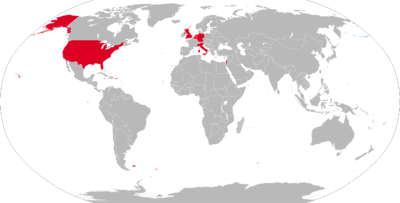MGM-52 Lance
| MGM-52 Lance | |
|---|---|
|
MGM-52 Lance missile on display at White Sands Missile Range Museum, New Mexico, next to M752 Self-Propelled Launcher. | |
| Type | Tactical ballistic missile |
| Place of origin | United States |
| Service history | |
| In service | 1972–1992 |
| Used by | U.S. Army, Britain, Belgium, Netherlands, Italy, and West Germany |
| Production history | |
| Manufacturer | LTV |
| Unit cost | ~US$800K (1996 dollars)[1] |
| No. built | 2,133[2] |
| Specifications | |
| Weight | 1,285–1,527 kg (2,850–3,367 lbs) depending on warhead[2] |
| Length | 6.1m (20 ft) |
| Diameter | 56 cm (22 in) |
| Warhead | 1 W70 nuclear or M251 high explosive submunitions[2] |
| Blast yield | 1–100 kt |
|
| |
| Engine | Liquid-propellant rocket |
Operational range | 70 km (45 mi) to 120 km (75 mi), depending on warhead[2] |
| Speed | >Mach 3 |
Guidance system | inertial guidance |
The MGM-52 Lance was a mobile field artillery tactical surface-to-surface missile (tactical ballistic missile) system used to provide both nuclear and conventional fire support to the United States Army. The missile's warhead was developed at Lawrence Livermore National Laboratory. It was replaced by MGM-140 ATACMS, which was initially intended to likewise have a nuclear capability during the Cold War.[3]
Deployment
The first Lance missiles were deployed in 1972, replacing (together with the US-Navy's nuclear-tipped RIM-2D & RIM-8E/B/D) the earlier Honest John rocket and Sergeant SRBM ballistic missile, greatly reducing the weight and bulk of the system, while improving both accuracy and mobility.[2]
A Lance battery (two fire units) consisted of two M752 launchers (one missile each. Those vehicles could carry the MGR-1 Honest John, for operational war-zone mission-dependent flexibility instead) and two M688 auxiliary vehicles (two missiles each),[2] for a total six missiles. The firing rate per unit was approximately three missiles per hour.
Payload
The payload consisted either of a W70 nuclear warhead with a yield of 1–100 kt or a variety of conventional munitions. The W70-3 nuclear warhead version was one of the first warheads to be battlefield-ready with an "enhanced radiation" (neutron bomb) capability. Conventional munitions included cluster bombs for use against SAM-Sites, heat seeking Anti-Tank Cluster munitions or a single unitary conventional shape-charged warhead for penetrating hard targets and for bunker busting. The original design considered a chemical weapon warhead option, but this development was cancelled in 1970.
Deactivation
The Lance missile was removed from service following the end of the Cold War and was partially replaced in the conventional role by the MGM-140 ATACMS.[4]
Operators

Former operators
![]() United States United States Army
United States United States Army
- 1st Battalion, 12th Field Artillery Regiment (1973–1992) Fort Sill, Oklahoma[2]
- 1st Battalion, 32nd Field Artillery Regiment (1975–1991) Hanau, Germany
- 6th Battalion, 33rd Field Artillery Regiment (1975–1987); redesignated as 6th Battalion, 32nd Field Artillery Regiment (1987–1991) Fort Sill[7] (One battery was forward deployed to South Korea)[8]
- 2nd Battalion, 42nd Field Artillery Regiment (1974–1987); redesignated as 4th Battalion, 12th Field Artillery Regiment (1987–1991) Crailsheim, Germany
- 3rd Battalion, 79th Field Artillery Regiment (1974–1986); redesignated as 2nd Battalion, 32nd Field Artillery Regiment (1986–?) Giessen, Germany
- 1st Battalion, 80th Field Artillery Regiment (1974–1987); redesignated as 3rd Battalion, 12th Field Artillery Regiment (1987–1991) Aschaffenburg, Germany
- 1st Battalion, 333rd Field Artillery Regiment (1973–1986); redesignated as 3rd Battalion, 32nd Field Artillery Regiment (1986–?) Wiesbaden, Germany
- 2nd Battalion, 377th Field Artillery Regiment (1974–1987); redesignated as 2nd Battalion, 12th Field Artillery Regiment (1987–1992) Herzogenaurach, Germany
- 50th Missile Regiment Royal Artillery
![]() Netherlands Royal Netherlands Army
Netherlands Royal Netherlands Army
- 129th Artillery Battalion (1979–1992)
![]() Belgium Belgian Land Component
Belgium Belgian Land Component
- 3rd Artillery Battalion
- 3rd Missile Brigade "Aquileia" (up to 1991, then from 1992 to 2001, 3rd Missile Rgt)
- 150th Rocket Artillery Battalion
- 250th Rocket Artillery Battalion
- 350th Rocket Artillery Battalion
- 650th Rocket Artillery Battalion
See also
- Sea Lance, a similarly named, but unrelated submarine-launched missile.
- List of military aircraft of the United States
- List of missiles
- M-numbers
References
- ↑ "Lance Missile (MGM-52C)". U.S. Nuclear Weapons Cost Study Project. Washington, DC: Brookings Institution. August 1998. Retrieved 11 October 2011.
- 1 2 3 4 5 6 7 Ripley, Tim. The new illustrated guide to the modern US Army. Salamander Books Ltd. pp. 92–93. ISBN 0-86101-671-8.
- ↑ Healy, Melissa (3 October 1987). "Senate Permits Study for New Tactical Nuclear Missile". Los Angeles Times. Retrieved 8 August 2012.
- ↑ "LTV MGM-52 Lance". Designation Systems. 92001. Check date values in:
|date=(help) - ↑ http://www.usarmygermany.com/Units/FieldArtillery/Org%20Charts_Lance1.htm
- ↑ http://www.usarmygermany.com/Units/FieldArtillery/Org%20Charts_Lance.htm
- ↑ http://www.globalsecurity.org/military/agency/army/6-32fa.htm
- ↑ http://wiley2-5fa.com/favorite.htm#lance
External links
| Wikimedia Commons has media related to MGM-52 Lance. |
- Video of Lance missiles being launched by British Army in 1992 – #1
- Video of British Army Lance launches in 1992 – #2
- Video of British Army Lance launches in 1992 – #3
- Redstone Arsenal History – Lance
- Herzobase.org – Lance Missile base in Germany
- Designation Systems Article
- Brookings Institution photos and data
